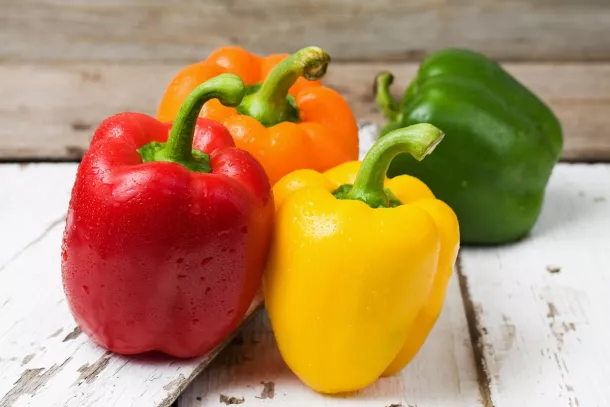
©Getty Images/showward
When buying peppers, you are usually spoiled for choice, because the healthy vegetable is available in a wide variety of variants: red, orange, yellow or green – there is also a large choice when it comes to colors. Then there are different shapes: while sweet peppers tend to be thick and round, spicy peppers have a longer and narrower shape. The different types of paprika also differ in taste: paprika is available in a wide variety of strengths, from sweet to hot. The vegetable has other names depending on the color, size and spiciness. Hot peppers and chillies also belong to the paprika family. However, the different varieties have something in common: peppers are healthy, have many vitamins and are low in calories. You can read more about the nutritional values, vitamins and other healthy ingredients of bell peppers in this article.
Nutritional values of peppers: vitamins, minerals & Co.
The different colors reflect the degree of ripeness of the vegetables: when they are not ripe, all the peppers are green, but over time they become yellowish or redder and therefore also sweeter in taste. There are also unusual colors like purple or white peppers.
But whether red, yellow or green, the ingredients of the peppers differ only slightly from each other: all colors and types of peppers have very few calories, depending on the degree of ripeness, 100 grams of peppers only bring it up 19 to 38 calories (kcal) or 80 to 159 kilojoules. This is because 100 grams of bell peppers contain only 3 to 6 grams of carbohydrates, 0.5 grams of fat and 1.3 grams of protein.
But peppers are not only healthy because they have very few calories, but also because of their ingredients. 100 grams of peppers contain, among other things:
- 120 milligrams C vitamin
- 2.5 milligrams of vitamin E
- 0.3 milligrams of niacin
- 177 milligrams of potassium
- 12 milligrams of magnesium
- 10 milligrams of calcium
- 0.4 milligrams of iron
In red peppers it is the vitamin C content particularly high compared to peppers of different colors. While 100 grams of green peppers contain about 120 milligrams of vitamin C, one tomato red pepper contains about 400 milligrams. This makes peppers one of the richest foods in vitamin C. For comparison: Oranges and lemons contain about 50 milligrams per 100 grams.
Healthier ingredients in peppers
In peppers they are also They contain flavonoids and carotenoids. Both are among the secondary plant substances.
Flavonoids have an antioxidant effect and are therefore said to have a major impact on human health. They act as radical scavengers in the body and reduce the risk of certain diseases. Positive effects on blood pressure and the immune system have been found in laboratory and animal experiments. Anti-inflammatory effects have also been demonstrated.
Carotenoids are mostly found in colorful fruits. They also have a cell-protective effect as an antioxidant and are said to have positive effects on the cardiovascular system and the immune system. The different colors of peppers are caused by different carotenoid pigments. Most carotenoids are red, but there are yellow pigments as well. Yellow, orange or red varieties therefore contain a higher proportion of carotenoids than green peppers.
The substance capsaicin is contained in the hottest types of peppers. Capsaicin does not irritate the taste buds on the tongue, but does trigger a heat and pain stimulus. The spiciness of peppers is determined using the Scoville index. Indicates the capsaicin content in the respective fruit. Regular sweet peppers contain almost no capsaicin and are therefore classified as mild on this scale. Cherry or chili peppers are considered hot, jalapenos are classified as semi-hot, and cayenne peppers are classified as hot. Capsaicin has a vasodilatory effect and promotes blood circulation.
The capsaicin contained in paprika is mainly used in so-called ABC patches, which are used to relieve rheumatic pains, due to its circulation-improving effect. Products containing capsaicin are also used for problems such as low back pain or migraines.
Allergies and other negative effects
In addition to these positive effects, varieties with a high capsaicin content are also suspected of triggering Stomach pain, diarrhoea, irritated mucous membranes or high blood pressure.
Occasionally, eating paprika can also trigger an allergy. This is usually a cross allergy: peppers probably contain a protein also found in birch or mugwort. People who are allergic to birch pollen can also have an allergic reaction when they eat bell peppers. People with fructose intolerance should also pay attention to peppers: while green peppers contain very little fructose, i.e. fruit sugar, at 1.2 percent, the content in red peppers is 2.3 percent, significantly more higher than in many other types of vegetables.
Use and conservation of peppers
Today, peppers are used in cooking almost everywhere in the world, both as a spice and as a vegetable. The hotter forms of peppers are mostly popular in southern countries like Mexico. The best known spice based on paprika is paprika powder. There are different types of paprika powder, depending on how hot it is.
To make the spice, the peppers are first dried and then ground. The hottest spices are obtained from different types of chili peppers, such as cayenne pepper of the cayenne pepper variety. Also, hot sauces like sambal oelek, tabasco sauce or ajvar are made with paprika.
As a vegetable, peppers can be used raw, stuffed, steamed or fried. A particularly popular recipe in Germany are stuffed peppers with rice or minced meat. Instead of ground beef, you can alternatively stuff the peppers with vegetables such as corn, tomatoes or beans and feta cheese.
Bell peppers can be a challenge for the gut, as some people may find it difficult to digest the vegetable’s high-fiber skin. Then it is advisable to peel the peppers.
Fresh peppers will keep for two or three days at room temperature. Ideally, peppers should be stored in the refrigerator, so the greens will keep for up to a week. The peppers can also be frozen easily: just wash the pods, remove the seeds, and then freeze the chunks.
Paprika: plant family and origin
Peppers belong to the nightshade family. This makes it closely related to plants such as tomatoes, eggplants and potatoes. However, while the tuber lying underground is used as food in the case of the potato, the fruit of the pepper is harvested.
Pepper plants form their own genus with the scientific name “Capsicum”. There are many varieties in this family. In general, a distinction is made between spicy peppers, which have a relatively spicy taste due to their high capsaicin content, and sweet peppers, which contain only little capsaicin.
Paprika is native to South America, from the area between Brazil and Bolivia. Over time, the seeds of the pepper plant were spread by birds as far as Central America. Today, peppers are grown all over the world in tropical and temperate zones.
Updated: 05/03/2023
Author:
Kathrin Mehner, medical editor | Jasmin Rauch, medical editor




